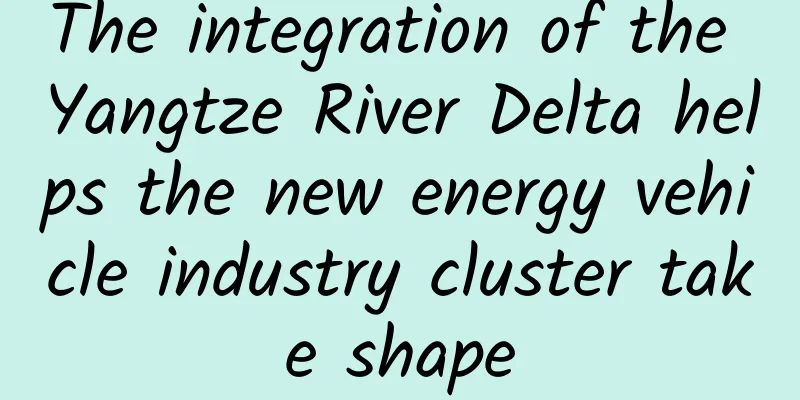The integration of the Yangtze River Delta helps the new energy vehicle industry cluster take shape

|
At the SAIC Volkswagen Ningbo base, the robotic arms on the assembly line are working hard without stopping. With an orderly rhythm, the SAIC Volkswagen Ningbo base rolls off a car every minute, and more than 1,000 new cars are shipped across the country every day. Since the SAIC Volkswagen Ningbo base was put into operation in 2013, the petrochemical industry has been the first pillar industry in Ningbo. With the commissioning of the Ningbo base, the industrial chain links such as parts manufacturing, testing, and training have gathered, and an automobile city has sprung up. Last year, automobiles have become the first pillar industry in Ningbo. SAIC Volkswagen Ningbo Base is one of SAIC Group's 200 enterprises and production bases in the Yangtze River Delta region. As the leader of China's automobile industry, SAIC Group has always expanded its industries based on the Yangtze River Delta for many years. After more than 30 years of development, SAIC Group has not only grown into the country's largest automobile group, with business covering four major sectors including complete vehicles, parts, service trade, and finance, but also actively explored forward-looking technologies such as new energy, the Internet, and car sharing, creating a leading advantage. The development of SAIC Group over the past 30 years is inseparable from the synergy brought about by the integration of the Yangtze River Delta. The automobile industry is a typical scale economy, with many related industries, many supporting links, a long industrial chain, and intensive technology and capital. Typical characteristics require that the region where it is rooted must not only have the functional advantages of gathering global resources, but also must have the first-mover advantage of active technological innovation, the brand advantage of creating a trend-setting brand, and the talent advantage. Among the urban agglomerations in the Yangtze River Delta, Shanghai has obvious advantages in innovation capabilities and service industry development level, Jiangsu has a dense advanced manufacturing industry, Zhejiang has a developed private economy, Anhui has rich innovation resources, and abundant labor resources - this resource differentiation and synergy is the most solid foundation for the Yangtze River Delta to further promote industrial integration. In addition to attracting old-line automakers such as SAIC Group to expand their presence here, the synergy brought about by the integration of the Yangtze River Delta has also led to the layout of some new car manufacturers in the Yangtze River Delta in the past two years, forming a linkage model with Shanghai as the headquarters and manufacturing bases in Jiangsu, Zhejiang and Anhui. Resource synergy: new and old car manufacturing forces are deployed in the Yangtze River Delta In March 2018, at the mouth of Oujiang River in Wenzhou City, the WM Motor New Energy Vehicle Intelligent Industrial Park was put into operation, and the first batch of WM Motor EX5 mass-produced vehicles rolled off the assembly line. In just 16 months, the WM Motor intelligent factory was built on the seaside and has the capacity for mass production. Such a speed is surprising. When talking about the reasons why the project was implemented in the Yangtze River Delta and why it could be advanced so quickly, Shen Hui, the founder of WM Motor, said: "The automobile industry has typical characteristics such as economies of scale, many related industries, many supporting links, long industrial chain, and technology and capital intensiveness. As the 'new Silicon Valley' of China's automobile industry, the integration of the Yangtze River Delta will help promote the formation of a new energy vehicle industry cluster in the Yangtze River Delta region. WM Motor can better integrate and utilize resources, optimize resource allocation, and achieve efficient and rapid development." Today, WM Motor’s global headquarters has settled in Shanghai, its smart factory has taken root in Zhejiang, its core supply chain has gathered in Jiangsu, and its new retail network has been deployed in the Yangtze River Delta. In addition to WM Motor, another new innovative energy vehicle company, NIO, has also chosen to develop in the Yangtze River Delta. Li Bin, founder of NIO, believes that the Yangtze River Delta will become a world-class innovation center for smart electric vehicles. This is due to the Yangtze River Delta's complete industrial and market foundations, and the accumulation of high-end talents in the entire chain of smart electric vehicles. The Yangtze River Delta is the only region with a world-class talent base. In the field of manufacturing, NIO has conducted in-depth cooperation with JAC in Hefei and built a new world-class all-aluminum body factory. In Jiangsu, NIO has set up three factories in Nanjing, Changshu and Kunshan to develop and manufacture electric drive systems. The advanced manufacturing base in Nanjing has an annual production capacity of 280,000 sets of high-performance EDS. In Shanghai, NIO is also investing in a new manufacturing base. Li Bin believes that the reason why the Yangtze River Delta is expected to become the world's innovation center for smart electric vehicles is, first of all, due to the Yangtze River Delta's industrial foundation. The entire electric vehicle industry chain is very complete, and China produces nearly 30 million vehicles a year. Most of the excellent parts companies are in the Yangtze River Delta, and logistics costs can be greatly saved. Secondly, the market. The Yangtze River Delta is the most economically developed region in China, with very strong purchasing power. NIO has currently received a large number of orders in various cities in the Yangtze River Delta. Green leadership: Yangtze River Delta is expected to become a global electric vehicle industry powerhouse For the Yangtze River Delta, the market and industrial chain are only the foundation for it to become a global automotive powerhouse. To become a global innovation center for electric vehicles, it relies on a good innovation environment and the motivation of enterprises to continuously innovate and upgrade and seek leadership in technology and models. As a long-established state-owned enterprise, SAIC has been insisting on technological and model innovation for many years. Zu Shijie, deputy chief engineer of SAIC, said: In SAIC's plan, SAIC hopes to build a collaborative innovation system with Shanghai as the leader in the Yangtze River Delta - at the front end of the industrial chain, focus on breakthroughs in key technologies to accumulate technological advantages for development, at the back end, focus on new businesses such as mobile travel, finance, and automotive after-sales services to create market space for transformation, and in the middle, integrate the new generation of information technology with manufacturing to improve the level of intelligent manufacturing; and from the beginning to the end, SAIC has also made every effort to promote the application of big data, cloud computing, artificial intelligence, etc., so that the group has formed a "data-driven development" trend. In the field of new energy, SAIC is determined to build a mainstream brand of new energy vehicles in the world. The goal is to establish SAIC's leading position in the domestic new energy vehicle industry by 2020 during the 13th Five-Year Plan period, create a new energy vehicle model that is a global industry benchmark in terms of technology, and establish innovative comprehensive solutions for new energy vehicle users. Special investment in the field of new energy vehicles exceeds 20 billion yuan, more than 30 new new energy vehicle models will be launched, and the annual sales target of new energy vehicles will exceed 600,000 vehicles. The achievement of SAIC's new energy goals depends on the support of surrounding supporting resources. As early as 2017, SAIC established SAIC Power Battery System Co., Ltd. and SAIC Power Battery Co., Ltd. with CATL, a unicorn company in the battery field, and invested more than 10 billion yuan to build a power battery and power battery system production base in Liyang, Jiangsu. CATL's breakthrough in battery technology, rapid product iteration, and scale effect will effectively reduce costs and form advantages. SAIC and CATL's integration of industry advantages will usher in a new era of China's new energy vehicles and will promote China's new energy vehicles to catch up with international competitors. Driven by innovation, the Yangtze River Delta helps the global automotive industry transform and upgrade At the Beijing Auto Show in April, the first fully interactive pure electric SUV in China, the WM EX5, brought by WM Motor Technology Co., Ltd., attracted the attention of many visitors. Positioning itself as a domestic emerging new energy vehicle product and travel solution provider, WM Motor hopes to provide Chinese consumers with a complete, convenient and comfortable travel experience based on global talent, technology, R&D, manufacturing and industrial chain resources. As the world enters the era of the Internet of Everything, cars are no longer just a means of transportation for people, but a smart mobile terminal with interactive and social functions. Aiming at this trend, as early as 2015, SAIC and Hangzhou Alibaba jointly established Zebra Technology, which launched the world's first mass-produced Internet SUV Roewe RX5. At present, the cumulative sales of Internet models represented by Roewe RX5 have exceeded 600,000 units, becoming a benchmark for Internet cars, and forming a series of Internet car product camps, establishing an Internet car ecosystem covering financial insurance, maintenance, navigation and entertainment, etc., which can open up the payment link, and add new service ecosystems such as touchless payment, smart parking, and smart refueling, further improving the user experience. In the field of business model innovation, based on the SAIC Global Car Sharing Platform, SAIC Motor is making every effort to promote the time-sharing rental business of new energy vehicles. Currently, EVCARD covers 17 cities in Jiangsu, Zhejiang and Anhui, and plans to increase the number of vehicles put into use in the above three provinces to 20,000 this year. Anyue Charging, a subsidiary of the group, has built more than 10,000 public charging piles in the Yangtze River Delta region. In Shen Hui's view, in the "Three-Year Action Plan for the Integrated Development of the Yangtze River Delta", the three provinces and one city are actively planning and formulating 5G trials and applications, leading the development of the digital economy in the Yangtze River Delta with the construction of a new generation of information infrastructure, and providing technical support for the future transformation and upgrading of the automotive industry in the Yangtze River Delta region. WM Motor's smart proposition is the interactive intelligence of the entire vehicle. Through LivingID, WM Motor will change the traditional state of "people adapting to the car" and let the car adapt to people. In the future, WM Motor's models will be 100% connected to the Internet. Through the combination of "AI + hardware + software + service", when using any WM Motor car, you can use the exclusive LivingID to automatically adjust to the car that the user is used to based on the cloud big data. WM Motor believes that the softwareization of hardware is the key to truly realizing the intelligence of automobiles and bringing users a new travel experience. In addition to vehicles, WM Motor is also committed to the intelligent manufacturing field. Its unique C2M customized production method can not only combine the creative needs of users and freely select and quickly realize customized production, but also drive upstream suppliers and downstream sellers to jointly carry out intelligent transformation, using data-driven to connect "demand-definition-R&D-manufacturing-promotion-channel-operation-iteration" and then return to the digital product closed loop of demand, empowering the entire industry chain together. By rationally planning the industrial system, optimizing the allocation of innovative resources, and flexibly responding to market changes, vehicle and parts companies in the Yangtze River Delta region are continuously improving their competitiveness, thus forming an intelligent automobile innovation cluster. Yangtze River Delta automobile companies are actively participating in high-level global competition and cooperation. As a winner of Toutiao's Qingyun Plan and Baijiahao's Bai+ Plan, the 2019 Baidu Digital Author of the Year, the Baijiahao's Most Popular Author in the Technology Field, the 2019 Sogou Technology and Culture Author, and the 2021 Baijiahao Quarterly Influential Creator, he has won many awards, including the 2013 Sohu Best Industry Media Person, the 2015 China New Media Entrepreneurship Competition Beijing Third Place, the 2015 Guangmang Experience Award, the 2015 China New Media Entrepreneurship Competition Finals Third Place, and the 2018 Baidu Dynamic Annual Powerful Celebrity. |
Recommend
Why is the sound quality of Bluetooth headphones so poor?
If anyone knows a little about audio, they will k...
Traffic model and homepage indicator system: Homepage strategy operation
During the long Spring Festival holiday, everyone...
Does a positive antigen test mean infection? What other questions do you have about antigen testing? Experts explain →
Can antigen testing and nucleic acid testing repl...
The Earth's "two-faced" inner core rotates faster than the surface
What causes the differential rotation of the Eart...
Recreating the “multi-grid” layout: Why is the Baliqiao site in Fangcheng, Henan Province said to be the “throat station” of the Erlitou royal capital?
Where is the important core settlement in the sou...
Analysis of Douyin short video competitors!
Analysis of Douyin short video competitors 1. Bac...
Lexus is going to play a trick and use the crossover SUV as the flagship
When it comes to the word flagship, the models th...
Should I be overly concerned about my iPhone's battery health? Not necessarily.
In the early days when Nokia was popular or when ...
Brother Han teaches you how to use iOS - Experience sharing
[[148033]] This article mainly explains 4 questio...
Xiaohongshu’s operational minefields are explained in one article!
In December last year, Xiaohongshu announced that...
What is the investment price of Haidong Rubber and Plastic Mini Program? Haidong Rubber and Plastic Mini Program Investment Price Inquiry
How much does it cost to attract investment for t...
Superconducting quantum computing: the vanguard in quantum error correction
Produced by: Science Popularization China Author:...
Taobao merchants' internet cables were cut at midnight on "Double 11"
The sales from 0:00 to 1:00 in the morning of &qu...









